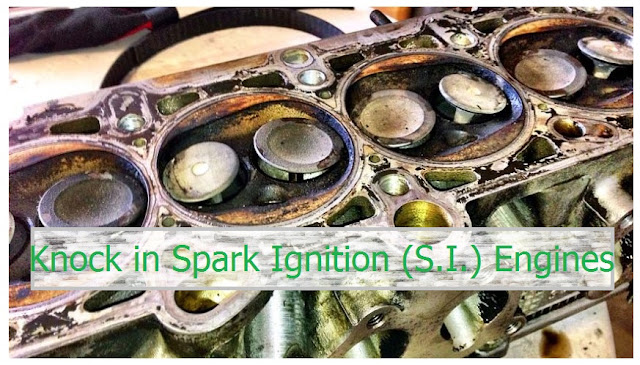
Knock, also known as detonation, is an undesirable phenomenon in spark ignition (S.I.) engines where combustion occurs abnormally within the cylinder. It leads to engine knocking or pinging sounds, reduced performance, and potential damage to engine components.
Causes of Knock in S.I. Engines
The primary causes of knock in S.I. engines include:
Hot Spots:
- Presence of hot carbon deposits or other materials in the combustion chamber that can ignite the air-fuel mixture prematurely.
High Temperature and Pressure:
- Increased cylinder temperatures and pressures lead to conditions that make the air-fuel mixture more prone to auto-ignition.
Low Octane Fuel:
- Using fuel with a low octane rating can increase the likelihood of knocking since it is less resistant to compression ignition.
Excessive Spark Advance:
- Timing the spark too early in the compression stroke can cause the mixture to ignite prematurely, resulting in knock.
High Compression Ratio:
- Engines with higher compression ratios are more susceptible to knocking because the air-fuel mixture can reach higher temperatures and pressures.
Inadequate Cooling:
- Poor cooling system performance can result in elevated engine temperatures, increasing the likelihood of knock.
Lean Air-Fuel Mixture:
- An excessively lean mixture can lead to higher combustion chamber temperatures, promoting conditions conducive to knock.
Engine Load and Speed:
- Operating under heavy loads or at high RPMs can increase the chances of knocking due to higher stresses within the engine.
Fuel Quality Variations:
- Variations in fuel quality and composition (such as ethanol content or contaminants) can affect the mixture's combustibility, leading to knock.
check this : Octane Number (O.N) and Engine Knocking
Types of Knock in Spark Ignition (S.I.) Engines

Knocking in S.I. engines can be classified into several types, each associated with different causes and characteristics:
Normal Knock (or Ping):
- This is a mild form of knocking typically associated with irregular combustion, but it doesn't cause significant damage. It may be caused by slight variations in fuel quality or combustion conditions.
Detonation Knock:
- This is a more severe form of knocking where part of the air-fuel mixture ignites spontaneously due to high temperature and pressure before the spark plug fires. It results in a sharp knocking sound and can lead to engine damage.
Pre-Ignition:
- Occurs when the air-fuel mixture ignites before the spark plug firing due to hot spots in the combustion chamber, such as carbon deposits or excessively high temperatures. This condition often results in severe engine damage.
Engine Rattle:
- This type of noise is a form of knock that may occur at certain RPMs and under specific loads. While it may not indicate serious engine issues, it can be uncomfortable and may suggest improper tuning.

check this : Ignition lag concept explained: causes and prevention
Effects of Knock in SI Engine
- Power Loss: Detonation can lead to decreased engine performance and efficiency.
- Engine Damage: Prolonged knocking can cause damage to pistons, cylinder heads, and spark plugs, leading to costly repairs.
- Increased Emissions: Knock can result in incomplete combustion, increasing engine emissions and affecting compliance with environmental regulations.
Prevention of Knock in SI Engine
Use Higher Octane Fuel:
- Selecting fuel with a suitable octane rating can help prevent knocking. Higher octane fuels resist premature ignition.
Optimize Engine Tuning:
- Proper tuning helps maintain correct ignition timing and fuel-air mixture to reduce the risk of knock.
Control Engine Temperature:
- Ensure efficient cooling systems and avoid conditions that lead to overheating.
Reduce Compression Ratio:
- In performance applications, adjusting the compression ratio can reduce knocking tendencies when using fuels of lower octane ratings.
Regular Maintenance:
- Keep the engine clean, especially the combustion chamber, to avoid the formation of hot spots due to carbon build-up.
Use Knock Sensors:
- Implementing knock sensors can help adjust ignition timing dynamically to prevent knocking during engine operation.
Conclusion
Understanding knock in S.I. engines is crucial for optimizing performance and avoiding potential engine damage. By recognizing the causes and implementing preventive measures, drivers can ensure smoother operation and prolong engine life.
If you have specific questions about knocking or related topics, feel free to ask!

Post a Comment